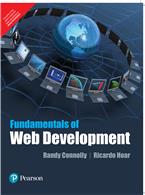Fundamentals of Web Development

|
Author(s):
Author:
Randy Connolly
- ISBN:9789332575271
- 10 Digit ISBN:9332575274
-
Price:Rs. 1000.00
- Pages:1024
- Imprint:Pearson Education
- Binding:Paperback
- Status:Available
-
|
Fundamentals of Web Development covers the broad range of topics required for modern web development (both client- and server-side) and is appropriate for students who have taken a CS1 course sequence. The book guides students through the creation of enterprise-quality websites using current development frameworks, its comprehensive coverage of a modern internet development platform includes HTML5, CSS3, Javascript, and the LAMP stack (that is, Linux, Apache, MySQL, and PHP). Other important technologies covered include jQuery, XML, WordPress, Bootstrap, and a variety of third-party APIs that include Facebook, Twitter, and Google and Bing Maps. Coverage also includes the required ACM web development topics in a modern manner closely aligned with best practices in the real world of web development. Teaching and Learning Experience
Help students master the fundamentals of web development: A true grasp of web development requires an understanding of both the foundations of the web and current web development practices.
Support learning outcomes in various teaching scenario: This book allows instructors to chart their own unique way through the topics that make up contemporary web development."
Table of Content
Chapter 1 How the Web Works, Chapter 2 Introduction to HTML, Chapter 4 HTML Tables and Forms, Chapter 4 HTML Tables and Forms, Chapter 5 Advanced CSS: Layout, ,Chapter 6 JavaScript: Client-Side Scripting , Chapter 7 Web Media, Chapter 8 Introduction to Server-Side Development with PHP,,Chapter 9 PHP Arrays and Superglobals,Chapter 10 PHP Classes and Objects ,Chapter 11 Working with Databases ,Chapter 12 Error Handling and Validation,Chapter 13 Managing State ,Chapter 14 Web Application Design,Chapter 15 Advanced JavaScript & jQuery,Chapter 16 Security ,Chapter 17 XML Processing and Web Services ,Chapter 18 Content Management Systems,Chapter 19 Web Server Administration ,Chapter 20 Search Engines,Chapter 21 Social Network Integration,
|
Salient Features
"Help students master the fundamentals of web development
Covers both the concepts and the practice of the entire scope of web development. Web development can be a difficult subject to teach because it involves covering a wide range of theoretical material that is technology independent as well as practical material that is very specific to a particular technology. This book comprehensively covers both the conceptual and practical side of the entire gamut of the web development world.
Focused on the web development reality of today's world and in anticipation of future trends. The world of web development has changed remarkably in the past decade. For instance, fewer sites are being created from scratch; instead, a great deal of current web development makes use of existing sophisticated frameworks and environments such as jQuery, WordPress, HTML5, and Facebook. It is important to integrate this new world of web development into any web development textbook.
Sophisticated, realistic, and engaging case studies. Rather than using simplistic ""Hello World"" style web projects, this book makes extensive use of three case studies: an art store, a travel photo sharing community, and a customer relations management system. For all the case studies, supporting material such as the business cases, use cases, design documentation, visual design, images, and databases are included. The authors have found that students are more enthusiastic and thus work significantly harder with attractive and realistic cases.
Comprehensive coverage of a modern internet development platform. In order to create any kind of realistic internet application, readers require detailed knowledge of and practice with a single specific internet development platform. This book covers HTML5, CSS3, Javascript, and the LAMP stack (that is, Linux, Apache, MySQL, and PHP). Other important technologies covered include jQuery, XML, WordPress, Bootstrap, and a variety of third party APIs that include Facebook, Twitter, and Google and Bing Maps.
Content presentation suitable for visually- oriented learners. As long time instructors, the authors are well aware that today's students are often extremely reluctant to read long blocks of text. As a result, they have tried to make the content visually pleasing and to explain complicated ideas not only through text but also through diagrams.
Content that is the result of over twenty years of classroom experience (in college, university, and adult continuing education settings) teaching web development. The book's content also reflects the authors' deep experience engaging in web development work for a variety of international clients.
Tutorial- driven programming content available online. Rather than using long programming listings to teach ideas and techniques, this book uses a combination of illustrations, short color coded listings and separate tutorial exercises. These step by step tutorials are not contained within the book, but are available online to owners of the book.
Complete pedagogical features for the student. Each chapter includes learning objectives, margin notes, links to step by step tutorials, advanced tips, keyword highlights, end of chapter review questions, and three different case study exercises.
Helpful teaching resources for the Instructor. To help make your web development course more teachable, the following resources are available for teachers adopting this book:
Attractive and comprehensive PowerPoint presentations (one for each chapter)
Images and databases for all the case studies
Solutions to end of chapter exercises and to tutorial exercises
Images and databases for additional case studies not covered in the book
Support learning outcomes in various teaching scenarios
There are many approaches to teach web development and this book is intended to work with most of these approaches.
Client-focused course for introductory students
Server-focused course for intermediate students
Advanced web development course
Infrastructure-focused course
All-in-one web development course"
|
|
|
|
|